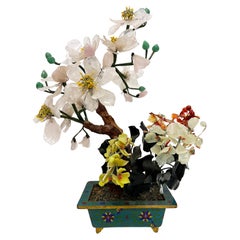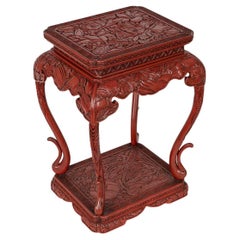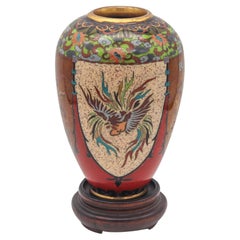Miami - Asian Art and Furniture
Early 20th Century Japanese Meiji Miami - Asian Art and Furniture
Wood
1970s Vintage Miami - Asian Art and Furniture
Jade, Copper, Enamel
1890s Japanese Meiji Antique Miami - Asian Art and Furniture
Ivory
1880s Chinese Chinese Export Antique Miami - Asian Art and Furniture
Lacquer
1890s Japanese Meiji Antique Miami - Asian Art and Furniture
Bronze, Enamel
Early 20th Century Burmese Miami - Asian Art and Furniture
Bamboo, Lacquer
Late 20th Century Chinese Miami - Asian Art and Furniture
Malachite
2010s Virgin Islands Modern Miami - Asian Art and Furniture
Sandstone
20th Century Asian Miami - Asian Art and Furniture
Walnut
Late 19th Century Chinese Chinoiserie Antique Miami - Asian Art and Furniture
Porcelain
21st Century and Contemporary African Modern Miami - Asian Art and Furniture
Ceramic
15th Century and Earlier Asian Antique Miami - Asian Art and Furniture
Stone
Late 19th Century Chinese Antique Miami - Asian Art and Furniture
Brass
20th Century Asian Chinoiserie Miami - Asian Art and Furniture
Ceramic, Pottery
Late 19th Century Chinese Antique Miami - Asian Art and Furniture
Brass
15th Century and Earlier Chinese Antique Miami - Asian Art and Furniture
Ceramic
Early 1900s Japanese Meiji Antique Miami - Asian Art and Furniture
Bronze, Copper, Enamel
Early 20th Century Japanese Meiji Miami - Asian Art and Furniture
Porcelain
Late 19th Century Chinese Antique Miami - Asian Art and Furniture
Brass
19th Century Philippine Tribal Antique Miami - Asian Art and Furniture
Iron
15th Century and Earlier Chinese Antique Miami - Asian Art and Furniture
Ceramic, Paint
Late 19th Century Japanese Edo Antique Miami - Asian Art and Furniture
Fabric, Wood
1890s Japanese Meiji Antique Miami - Asian Art and Furniture
Wood, Paint
1870s Japanese Meiji Antique Miami - Asian Art and Furniture
Giltwood, Lacquer, Wood, Ebony
Early 20th Century Burmese Miami - Asian Art and Furniture
Bamboo, Lacquer
1890s Chinese Qing Antique Miami - Asian Art and Furniture
Wood, Ivory
1810s Japanese Edo Antique Miami - Asian Art and Furniture
Agate, Gold
Early 19th Century Chinese Antique Miami - Asian Art and Furniture
Wood, Paint
18th Century Japanese Edo Antique Miami - Asian Art and Furniture
Silver
15th Century and Earlier Syrian Classical Roman Antique Miami - Asian Art and Furniture
Agate, Gold
Late 18th Century Chinese Antique Miami - Asian Art and Furniture
Wood
Early 1800s Japanese Edo Antique Miami - Asian Art and Furniture
Coral
Late 18th Century Chinese Antique Miami - Asian Art and Furniture
Wood
Mid-19th Century Chinese Antique Miami - Asian Art and Furniture
Leather, Lacquer
20th Century Japanese Anglo-Japanese Miami - Asian Art and Furniture
Enamel
Early 20th Century French Miami - Asian Art and Furniture
Wood
19th Century Chinese Qing Antique Miami - Asian Art and Furniture
Enamel, Brass
1890s Japanese Meiji Antique Miami - Asian Art and Furniture
Jade, Gold, Silver, Bronze, Enamel
19th Century Chinese Qing Antique Miami - Asian Art and Furniture
Lacquer
15th Century and Earlier Chinese Han Antique Miami - Asian Art and Furniture
Iron
15th Century and Earlier Chinese Tang Antique Miami - Asian Art and Furniture
Clay, Earthenware, Pottery
15th Century and Earlier Chinese Tang Antique Miami - Asian Art and Furniture
Earthenware, Pottery
15th Century and Earlier Chinese Medieval Antique Miami - Asian Art and Furniture
Bronze
1890s Japanese Meiji Antique Miami - Asian Art and Furniture
Silver, Bronze, Enamel
19th Century Chinese Antique Miami - Asian Art and Furniture
Limestone
15th Century and Earlier Chinese Tang Antique Miami - Asian Art and Furniture
Earthenware, Pottery
15th Century and Earlier Chinese Archaistic Antique Miami - Asian Art and Furniture
Earthenware, Pottery
1890s Japanese Meiji Antique Miami - Asian Art and Furniture
Wood
1890s Japanese Meiji Antique Miami - Asian Art and Furniture
Multi-gemstone, Gold, Silver, Sterling Silver, Gold Leaf
Early 1900s Japanese Meiji Antique Miami - Asian Art and Furniture
Gold, Silver, Sterling Silver
20th Century American Japonisme Miami - Asian Art and Furniture
Brass
1890s Japanese Meiji Antique Miami - Asian Art and Furniture
Wood
15th Century and Earlier Chinese Tang Antique Miami - Asian Art and Furniture
Earthenware, Pottery
1890s Japanese Meiji Antique Miami - Asian Art and Furniture
Wood
15th Century and Earlier Chinese Archaistic Antique Miami - Asian Art and Furniture
Earthenware, Clay, Paint
1940s Chinese Chinese Export Vintage Miami - Asian Art and Furniture
Multi-gemstone, Rock Crystal, Silver, Sterling Silver, Enamel
20th Century American Miami - Asian Art and Furniture
Plaster
Early 1900s Japanese Meiji Antique Miami - Asian Art and Furniture
Coral, Bronze
Read More
Chicago’s Pagoda Red Has a Spirited Mix of Asian Antiques and Bold New Art
For 25 years, gallerist Betsy Nathan has leveraged her keen eye and key connections to bring a unique selection of rare finds to the market.
In L.A., Gallerist JF Chen Has Long Championed Eclectic Blue-Chip Design
Now working alongside his daughter Bianca, dealer Joel Chen has presented a most covetable array of antiques, art and contemporary creations for more than 40 years.
12 Calming Spaces Inspired by Japanese Design
From cherry-blossom-adorned walls paired with glamorous lighting to wood-paneled ceilings above checkerboard-patterned chairs, these 12 spaces seamlessly blend Eastern and Western aesthetics.
Rodrigo Rivero Lake’s Mexico City Showroom Is a Museum-Worthy Trove of Spanish Colonial and Asian Antiques
The dealer and curator has spent the past 50 years amassing a collection of exceptional art, furniture and architectural elements that trace the cultural influence of the Spanish empire from Europe to the Americas and beyond.
16 Refined Asian-Inspired Interiors
These spaces exemplify how Eastern elements elevate a home's decor.





